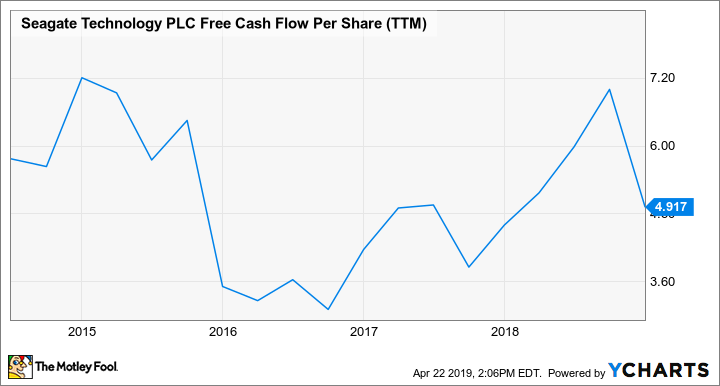Computer storage specialist Seagate Technology (STX +0.00%) makes most of its money from selling hard disk drives. While such drives are being displaced in markets like consumer PCs by faster and lower-power NAND flash-based solutions, hard disk drives still offer significant advantages in cost per gigabyte over NAND flash solutions. This means that for applications where lots of storage is needed at relatively low cost (think data centers), hard disk drives are still in robust demand.
Seagate is also making a push into solid-state drives, though its efforts there are still relatively small contributors to the company's overall financial performance.
While Seagate isn't a fast-growing business -- analysts expect the company's sales to decline by 7.5% in fiscal 2019 followed by a more modest 2.7% drop in fiscal 2020 -- it's a business that consistently throws off a lot of free cash flow. Presumably in a bid to make its shares attractive to income-oriented investors, Seagate returns a large portion of its FCF to shareholders in the form of a generous dividend. As of this writing, the company's dividend yield stood at 5.26%, making it one of the highest-yield names in tech.

Image source: Seagate.
Here, I'd like to go over what investors need to know about that dividend yield.
Is Seagate pushing it?
Whenever you come across a company that offers an unusually high dividend yield, it's important to check: Is that dividend the real deal? Or is it a "yield trap," meaning that the dividend looks high but is fundamentally unsustainable?
To determine whether Seagate's dividend is a yield trap, let's look at how much free cash flow the company generated per share over the last twelve months. That figure, though down significantly from its recent peak, works out to just shy of $4.92 per share. This means that Seagate's current dividend of $2.52 per share annually makes up a little more than half of what it generated in FCF per share.
STX Free Cash Flow Per Share (TTM) data by YCharts.
This is a good indication that Seagate's dividend is the real deal.
It's also important to realize that Seagate has significant debt, and the company needs to pay interest on that debt. During the first six months of the company's fiscal year 2019, the company incurred interest expense of $114 million, or a tad more than $0.39 per share; annualized, this is $0.78. This means that the company's dividend and interest expense combined are $3.30, still significantly short of what the company generated in free cash flow over the last twelve months, providing additional support to the idea that Seagate's dividend is sustainable.
Why isn't it growing?
Many income investors (quite rightly, I might add) don't look just at the size of a company's dividend yield, but also at its history of dividend increases. A company that's able to consistently grow its dividend each year -- a sign that the business itself is trending upward -- is probably more attractive to an income-oriented investor than a company that pays a large dividend but rarely (or sporadically) increases it.
Seagate, unfortunately, hasn't raised its dividend in a while, with the last raise coming back in late 2015. This is likely due to a couple of factors. First, Seagate's free cash flow has come down significantly from its recent peak. The company might be wary of increasing the dividend further -- especially since the stock already sports a robust dividend yield -- to give itself additional financial flexibility if its free cash flow were to drop significantly from current levels.
STX Dividend data by YCharts.
Indeed, the company does allocate a significant part of its free cash flow to share repurchases (it has spent $286 million on such repurchases year to date, close to the $361 million that it's dished out in the form of dividends). Share repurchases can be modulated up and down based on near-term business conditions without causing much of a ruckus, but investors would look very unfavorably on a dividend cut.
Moreover, with analyst consensus calling for Seagate's revenue to drop in the current and subsequent fiscal years, raising the dividend might look less like an attempt to share the wealth with stockholders and more like a desperate and imprudent move designed to make its stock more attractive.
Put simply, I don't think it's likely that Seagate will boost its dividend until it becomes clear that the storage specialist will return to consistent FCF growth.
Investor takeaway
On one hand, the sheer size of its dividend yield at current price points could make Seagate interesting to income investors. On the other, the lack of dividend growth in recent years -- likely a result of the company's volatile free cash flow -- could put some of those income investors off of the stock.


